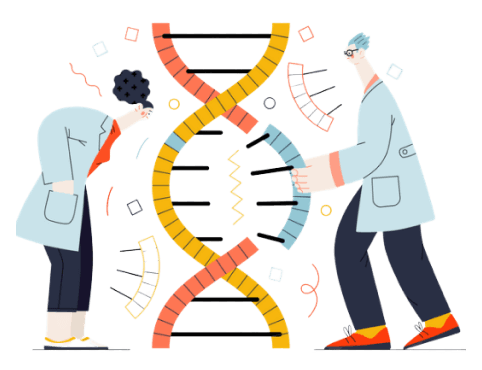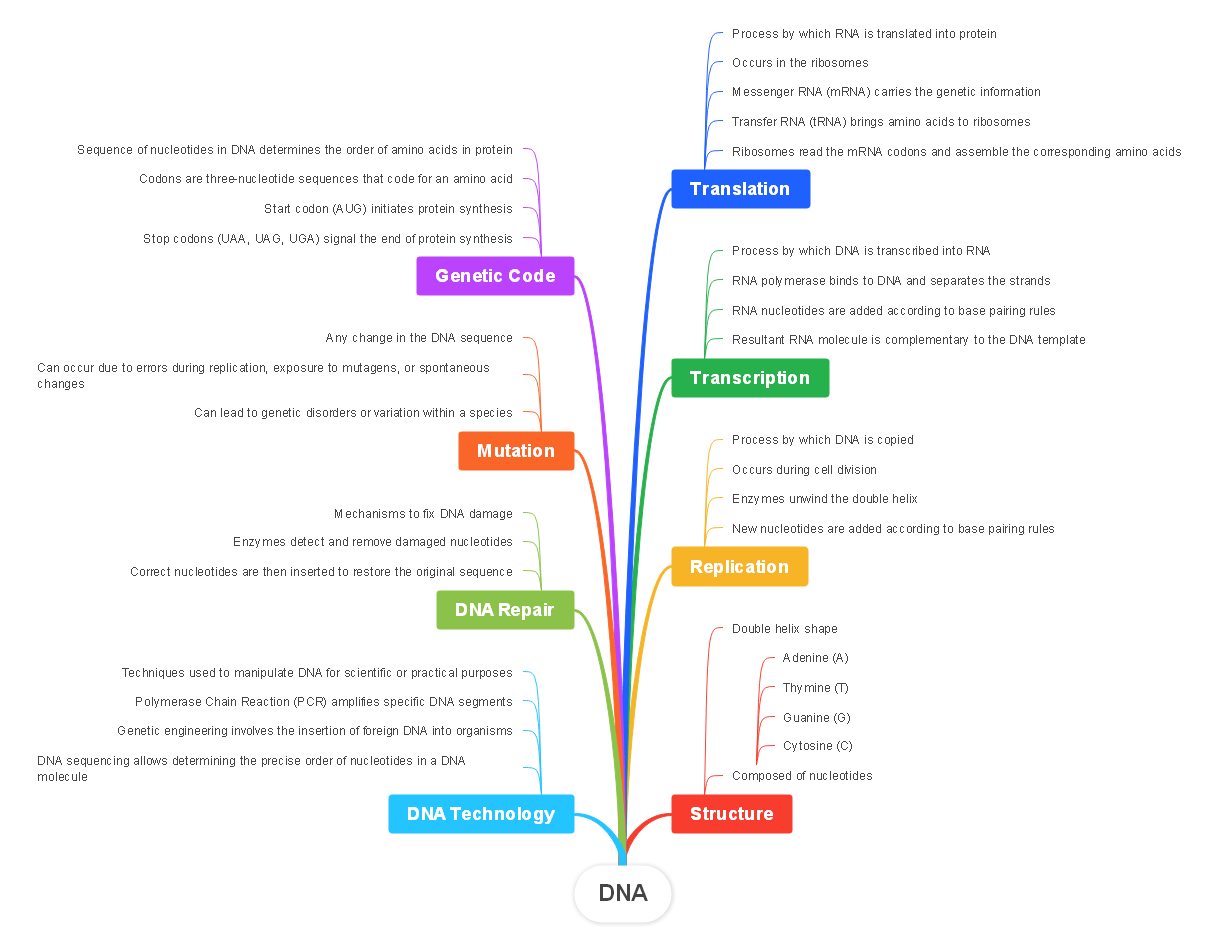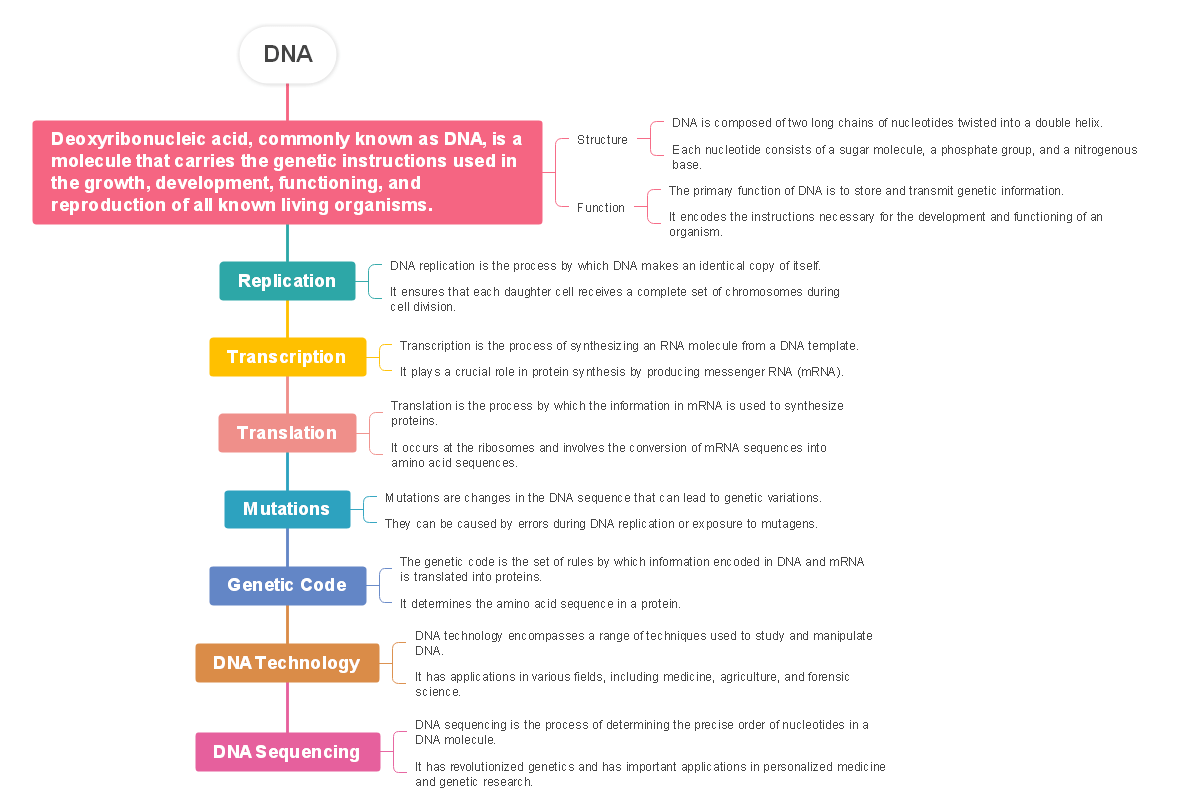Deoxyribonucleic acid, or DNA, is not new to us all. Our science classes and other curricular engagements have already given us an overview of this scientific topic. In a nutshell, DNA refers to a biological material holding the genetic information that makes us who we are. That’s at least what our teachers have taught us.
However, it’s important to point out that DNA is a very complicated subject of discussion. There’s so much more to it that we need to understand from a broader perspective. Don’t worry. We will help you wrap your head around this topic using a DNA concept map. Keep reading below to learn more.
In this article
What is DNA
DNA defines the function and identity of living organisms. It’s an organic molecule encapsulating our unique genetic code and vital hereditary information. To put it simply, DNA is responsible for everything about us. It provides a distinctive pattern that influences every life form's physical attributes and general personality.
From a microscope, DNA looks like a spiral ladder. The two strands of sugar and phosphate molecules act as its main structure. Attached to them is a set of chemical bases arranged in a specific sequence. The genetic code is determined according to the particular order of the adenine, cytosine, guanine, and thymine bases in DNA.
Our DNA is capable of creating exact copies of itself. It is essential to certain body processes that involve cell cycle and division. However, delving into those discussions requires an intuitive understanding of them. The topic must be simplified into pieces of information that provide clarity and meaning.
In this regard, a DNA concept map can be of great help. It is an understandable visual representation for certain discussions that are hard to grasp in plain texts. Don’t worry. Creating a concept map for DNA replication and other processes using a mind-mapping tool is now easy.
How DNA Works
DNA is the fundamental genetic material that stores instructions for the development and functioning of all living organisms. Structurally, it consists of two long chains forming a double helix, each composed of nucleotide units. The specific sequence of these bases encodes genetic instructions that dictate the synthesis of proteins, the building blocks of life. These nucleotides contain four bases:
- Adenine is one of the four nitrogenous bases in DNA. It forms a complementary base pair with thymine (T) through two hydrogen bonds. Adenine plays a crucial role in the genetic code, determining the specific sequence of amino acids during protein synthesis.
- Thymine is another nitrogenous base in DNA. It complements adenine (A) through two hydrogen bonds, forming the A-T base pair. Thymine is essential for maintaining the structural integrity of the DNA molecule and is involved in the accurate transmission of genetic information during processes like DNA replication.
- Cytosine is one of the pyrimidine bases in DNA, forming a complementary base pair with guanine (G) through three hydrogen bonds. The pairing of cytosine and guanine is crucial for maintaining the stability of the DNA double helix structure. Cytosine's sequence in the DNA molecule is transcribed into mRNA during gene expression.
- Guanine is a purine base in DNA that pairs with cytosine (C) through three hydrogen bonds. This complementary base pairing is fundamental to the accurate replication and transmission of genetic information. Guanine and adenine contribute to the genetic code's diversity and play a key role in protein synthesis.
The process of DNA functioning involves replication, transcription, and translation. During replication, DNA duplicates itself to ensure genetic continuity during cell division. Transcription involves the synthesis of RNA from DNA, serving as a messenger for protein production. Finally, translation interprets the RNA code to assemble amino acids into proteins, the building blocks of life. This intricate system governs the traits and characteristics of living organisms.
The History of DNA Models
The history of DNA models is marked by significant breakthroughs in understanding the molecular structure of deoxyribonucleic acid (DNA). The quest to unravel the intricacies of DNA began in the mid-20th century, and key milestones include:
1. Early Models
Before the definitive discovery of the DNA double helix, scientists like Linus Pauling proposed models, such as the triple helix, to explain the structure of DNA. However, these early models lacked experimental support.
2. Watson and Crick's Double Helix (1953)
The watershed moment in DNA model history occurred in 1953 when James Watson and Francis Crick, with crucial insights from Rosalind Franklin's X-ray diffraction images, unveiled the double helical structure of DNA. Their model depicted DNA as a twisted ladder with complementary base pairs forming the rungs.
3. Chargaff's Base Pairing Rules
Erwin Chargaff's discovery of the consistent ratios between adenine-thymine and cytosine-guanine in DNA provided critical insights into the base composition, reinforcing the structural foundations of the double helix.
4. Advancements in Structural Biology
Over subsequent decades, advancements in structural biology, such as high-resolution imaging techniques, refined our understanding of DNA's three-dimensional structure, shedding light on its dynamic nature.
The collaborative efforts of scientists and the integration of experimental evidence have continuously shaped and refined our models of DNA, enhancing our comprehension of the molecule's pivotal role in genetics and inheritance. The historical journey of DNA models reflects the evolving nature of scientific inquiry and the collaborative spirit driving advancements in molecular biology.
DNA Concept Map Template
By harnessing the power of visualization, EdrawMind's concept maps transform abstract concepts into tangible, accessible knowledge, fostering a deeper understanding of DNA's role in life sciences. Let's embark on an educational journey using these meticulously crafted DNA concept maps:
1. Reverse Tree Map for DNA Concept Map Template
EdrawMind's DNA Concept Map in the Reverse Tree Map template offers a brief overview of DNA. It covers DNA structure, replication, transcription, translation, the genetic code, mutations, DNA repair, and DNA technology. The structure is illustrated as a double helix with nucleotides (A, T, G, C). Replication involves unwinding the helix and adding new nucleotides.
Transcription transforms DNA into complementary RNA, while translation assembles proteins based on RNA codons. The genetic code dictates amino acid sequences. Mutation explores changes in DNA sequences, and repair mechanisms fix damages. DNA technology encompasses techniques like PCR, genetic engineering, and sequencing. This template is a concise visual guide to understanding the complexities of DNA replication concept map.
2. Top Bottom Timeline for DNA Concept Map Template
EdrawMind's TopBottom Timeline DNA Concept Map succinctly covers the structure and functions of DNA, its replication process, common errors, and repair mechanisms. It explores DNA's vital roles in genetic information storage, protein synthesis, gene regulation, and identification through DNA fingerprinting.
The template introduces key DNA technologies like Polymerase Chain Reaction (PCR), DNA sequencing, and genetic engineering. In the context of human health, it touches upon genetic disorders, pharmacogenomics, personalized medicine, and DNA-based diagnostics. This template is a comprehensive and concise guide to understanding DNA and its diverse applications.
3. Vertical Timeline for DNA Concept Map Template
EdrawMind's Vertical Timeline DNA Concept Map concisely explores the intricacies of DNA, spanning its structure, functions, replication, transcription, translation, mutations, genetic code, DNA technology, and sequencing. It emphasizes DNA's vital role in storing genetic information. The template navigates through the DNA replication, concept map and DNA structure concept map, underscoring their significance in cell division and protein synthesis.
Additionally, it delves into mutations, the genetic code, and the diverse applications of DNA technology, including sequencing for personalized medicine and genetic research. This succinct template serves as a valuable guide to unraveling the core aspects of DNA and its multifaceted applications across various domains.
Conclusion
The exploration of DNA, its structure, functions, and historical context underscores its pivotal role in the biological realm. Wondershare EdrawMind's Concept Map templates, like the Reverse TreeMap and Vertical Timeline for DNA, offer a concise and visually engaging way to grasp the complexities of this molecule. These templates serve as a valuable resource for educators, students, and researchers, condensing vast information into clear visual representations.
By leveraging EdrawMind, users can create dynamic and insightful DNA concept maps, enhancing the learning experience and fostering a deeper understanding of this fundamental biological entity.





 below.
below.  below.
below. 

